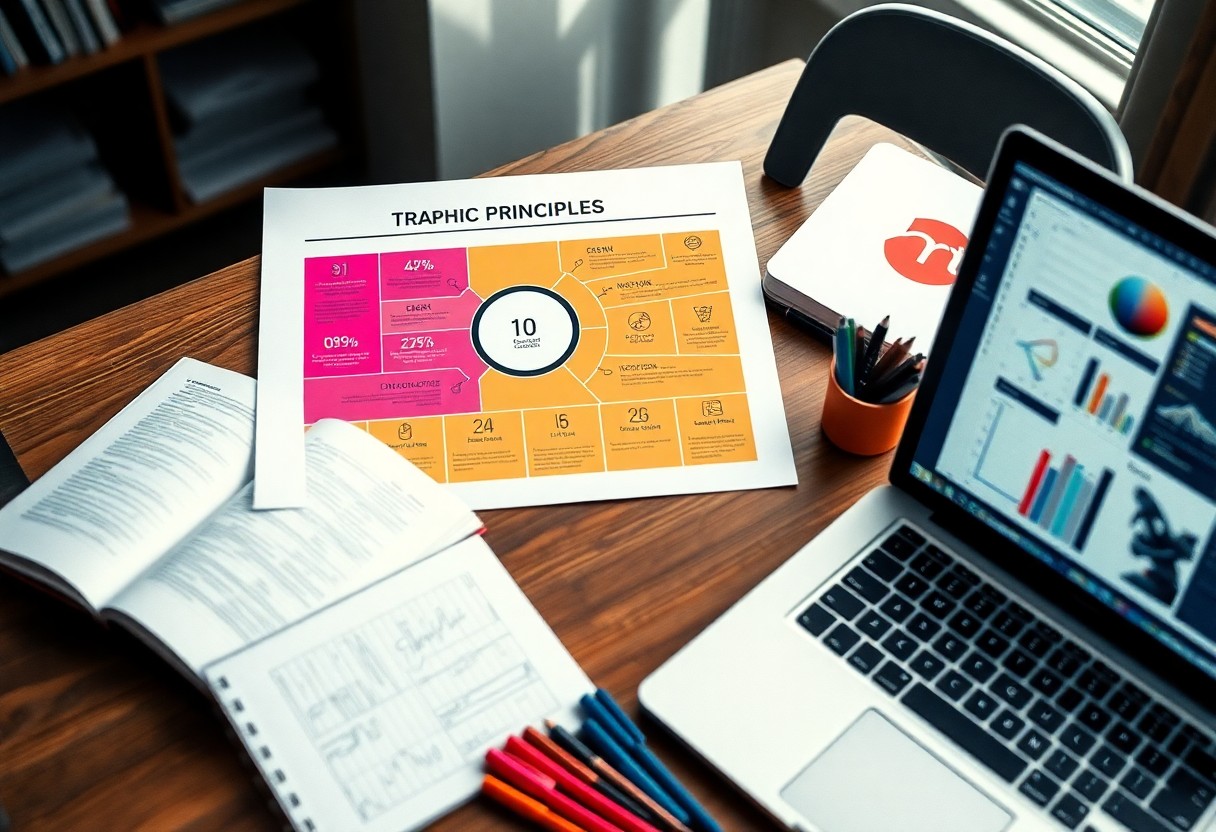Most businesses underestimate the impact of effective graphic design on their digital marketing strategy. By harnessing the power of visual communication, you can create compelling content that engages your audience and drives conversions. This listicle will guide you through ten necessary graphic design principles that will not only enhance your marketing efforts but also help you build a cohesive brand identity. Whether you’re a seasoned marketer or just starting, these principles will empower you to craft visuals that resonate with your target audience and achieve your marketing goals.
The Power of Color Psychology
Understanding color psychology is crucial in enhancing your digital marketing strategy. Colors can evoke emotions and drive consumer behavior, making them powerful tools in your branding. By strategically incorporating colors that resonate with your target audience, you can create a more compelling and memorable experience that aligns with your brand message. Utilize color not just for aesthetics, but as an influential factor that can enhance your campaigns and foster stronger connections with your customers.
Emotional Impact of Color Choices
The colors you choose in your marketing materials play a significant role in how your audience perceives your brand. Each color elicits different emotions; for example, blue often conveys trust, while red can evoke excitement. By carefully considering the emotional implications of your color choices, you can create a deeper emotional connection with your audience, ultimately influencing their purchasing decisions.
Crafting Color Palettes for Brand Identity
Creating a distinctive color palette is crucial for establishing a recognizable brand identity. Your color choices should reflect your brand’s personality and values, while also appealing to your target audience. Aim for a harmonious combination of colors that not only represents your brand but also distinguishes it from competitors. This deliberate selection helps to foster brand loyalty and recognition over time.
When crafting color palettes for your brand identity, consider using a primary color that embodies your brand’s essence, complemented by a few secondary colors that harmonize well together. This approach allows for versatility in different applications while maintaining a cohesive look. Keep in mind the psychological effects of each color, balancing vibrant hues that capture attention with more muted tones that evoke a sense of trust and reliability. Consistently applying this palette across all your digital marketing materials will create a unified visual language that strengthens your brand’s presence in the market.
The Art of Typography in Digital Communication
Typography plays a vital role in digital communication, as it not only conveys your message but also shapes your brand’s identity. The typeface you choose can evoke emotions, set the tone, and ensure clarity in your message. By mastering typography, you can create visually appealing content that engages your audience and enhances their understanding. Ultimately, the right typography decisions can elevate your digital marketing strategy, making your content more impactful.
Selecting Fonts that Resonate
Choosing the right fonts is necessary for establishing a connection with your audience. Your font selection should align with your brand’s personality and the message you wish to convey. Consider the emotions each typeface evokes and ensure that it complements your overall design. Mixing fonts can be effective, but limit your selection to two or three that work harmoniously together to maintain consistency and avoid overwhelming your readers.
Hierarchy and Readability in Text Layout
Establishing hierarchy and readability in your text layout helps guide your audience through your content effortlessly. By varying font sizes, weights, and styles, you can emphasize important information and create a visual flow that enhances user experience. Utilizing headings, subheadings, and bullet points not only enhances clarity but also aids in skimming, allowing readers to digest information quickly and efficiently. A well-organized text layout ensures that your necessary messages aren’t lost amid a cluttered design.
To achieve effective hierarchy and readability, start by selecting a clear base font for your body text that maintains legibility at various sizes. Use larger, bolder typography for headings to draw attention and create a natural flow for the eye. Additionally, integrate sufficient white space around text elements to prevent crowding and allow your audience to focus on each piece of content distinctly. Be consistent in your layout choices across different mediums to reinforce your brand’s professionalism and coherence.

Visual Hierarchy: Guiding the Viewer’s Eye
Understanding visual hierarchy is necessary for effective graphic design and helps you guide the viewer’s eye through your content seamlessly. By prioritizing elements based on their importance, you can create a pathway that directs your audience’s attention where it needs to go. By using size, color, and contrast, you make sure key messages stand out, ultimately enhancing user experience and effectiveness of your digital marketing strategy.
Techniques for Establishing Dominance
To establish dominance in your design, utilize size, contrast, and color strategically. Larger elements naturally draw more attention, while contrasting colors help important information pop against the background. Incorporate focal points—such as images or headings—where you want your audience to focus, thus creating a hierarchy that guides them through the content.
Balancing Elements for Effective Information Flow
Balancing elements in your design helps ensure that information flows logically and is easy for your audience to digest. By distributing visual weight evenly across the layout, you prevent overwhelming your viewers with cluttered visuals. Use spacing and alignment to create a cohesive structure that enhances readability and maintains your audience’s interest throughout the entire piece.
To achieve effective information flow, carefully consider the placement of each element within your design. Aim for a harmonious distribution of text, images, and white space to create a visually appealing layout. This balance encourages readers to engage with your content effortlessly, guiding them naturally from one point to the next. Additionally, using a grid system can help you maintain organization and precision, further enhancing the clarity and effectiveness of your digital marketing materials.
The Subtle Science of White Space
White space, often referred to as negative space, is not merely an absence of content; it serves as a vital design element that enhances user experience. By effectively utilizing white space in your digital marketing assets, you create a harmonious balance between text, images, and overall layout. As you incorporate white space thoughtfully, you elevate the visual appeal of your designs and facilitate easier navigation for your audience. This practice not only improves aesthetic appeal but also guides viewers toward key messages and actions, ultimately driving engagement.
Enhancing Focus and Clarity
By integrating white space into your design, you allow your audience’s eyes to rest and direct their focus toward imperative elements. This creates a clearer visual hierarchy, making it easy for viewers to identify the most important information and calls to action. The use of white space helps break down complex content, making it more digestible and retaining your audience’s attention on what truly matters.
Preventing Overwhelm in Design
Overwhelming your audience with cluttered visuals inevitably detracts from their overall experience. White space acts as a buffer, separating different sections and components of your layout. With a well-balanced design, you provide your audience with a sense of calm and organization, allowing them to process information effectively. A clean layout encourages engagement, making it easier for your audience to connect with your message.
Moreover, when you reduce visual clutter, you enhance the likelihood that your audience will take action. A design filled with numerous elements can confuse viewers, leading to a lack of engagement. By allowing white space to prevail, you ensure that each element within your design has room to breathe, which prevents overstimulation. This thoughtful arrangement guides your audience’s journey through your content, ultimately fostering a seamless connection with your brand and message.
Consistency is Key: Building Brand Recognition
Establishing a strong brand presence in digital marketing hinges on consistency. When you maintain uniformity in your design elements—such as colors, typography, and imagery—you help your audience form a clear association with your brand. This reliability creates trust and familiarity, making it easier for potential customers to recognize and recall your brand across various platforms.
Creating Cohesive Visual Elements
Cohesive visual elements play a vital role in brand storytelling. By using a unified color palette, consistent typography, and recognizable imagery, you ensure that your messaging is both memorable and impactful. This synergy in design not only captivates your audience but also communicates your brand personality effectively, reinforcing your identity in a crowded digital space.
The Role of Templates in Digital Marketing
Templates provide a streamlined approach to achieving brand consistency across your marketing materials. By utilizing pre-designed templates that align with your brand’s visual identity, you save time while ensuring that all your digital assets present a harmonious look. This consistency not only enhances your brand recognition but also simplifies the design process, allowing you to focus on your content and strategic goals.
Using templates in digital marketing is a smart move for maintaining consistency. With templates, you can easily adapt your designs for various platforms—be it social media, email campaigns, or website graphics—while ensuring that all elements reflect your brand’s aesthetic. They allow you to create high-quality visuals quickly, which can be particularly helpful when you have tight deadlines. Additionally, templates enable your team to work collaboratively, as they provide a clear framework that everyone can follow, reducing the risk of design discrepancies.
Imagery that Speaks: The Use of Visual Storytelling
Visual storytelling is a powerful tool in digital marketing, as it allows you to convey complex ideas quickly and effectively. By combining visuals with your brand narrative, you can create a deeper emotional connection with your audience, leading to increased engagement and retention. Leveraging imagery effectively means understanding how visuals resonate with your target demographic, ensuring they not only enhance your message but also inspire action.
Choosing Compelling Images that Align with Messages
Selecting the right images is imperative for reinforcing your marketing messages. You should aim for visuals that resonate with your brand’s identity and evoke the desired emotional response. High-quality and relevant images can help you illustrate key points and make your content more memorable. Consider your audience’s preferences and the context in which they’ll view these images, as this will guide your choices in a way that strengthens your overall message.
The Impact of Infographics on Audience Engagement
Infographics are an effective way to present data and complex information in a visually engaging format. They combine graphic design and data storytelling to capture your audience’s attention while providing clarity on important concepts. By breaking down information into digestible visuals, you can enhance understanding and retention, leading to higher engagement rates and shares across platforms. Infographics not only simplify information but also entice viewers, making them more likely to interact with your content.
When you incorporate infographics into your digital marketing strategy, you transform data-heavy information into a visual format that appeals to both the analytical and creative sides of your audience. This not only boosts the likelihood that your message will be understood but also encourages your audience to share your content, reaching new potential customers. Crafting infographics that are aesthetically pleasing and informative gives your audience a reason to engage further with your brand and enhances your authority in your industry.
Final Words
The 10 imperative graphic design principles you’ve explored can significantly elevate your digital marketing strategy. By implementing these principles, you’ll create more engaging visuals that resonate with your audience and enhance your brand identity. Understanding how to balance elements like contrast, alignment, and typography allows you to craft impactful messages that capture attention and drive action. As you apply these techniques, you’ll see how thoughtful design can transform your marketing efforts, making them not only more effective but also more memorable for your audience.

